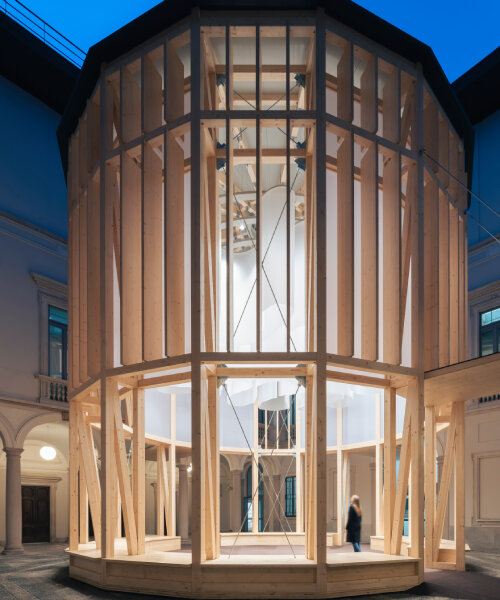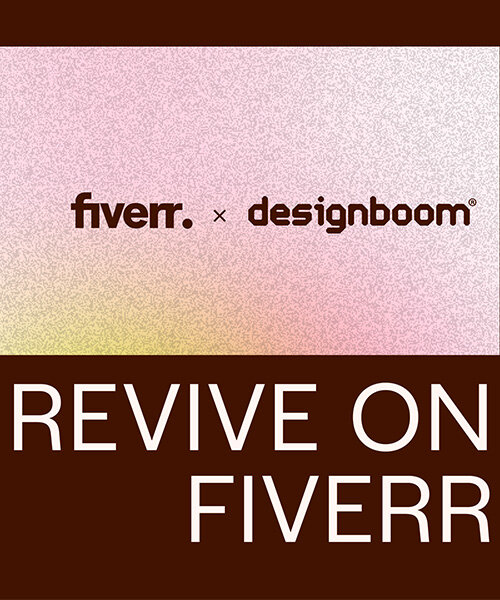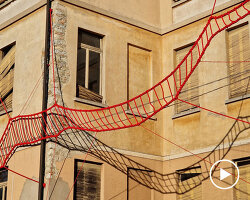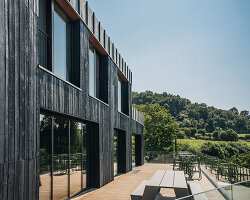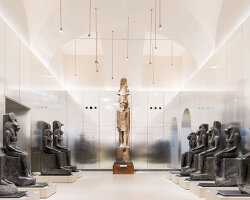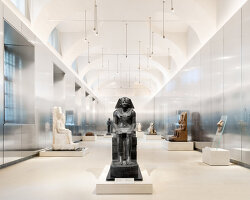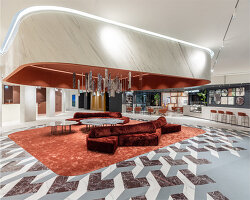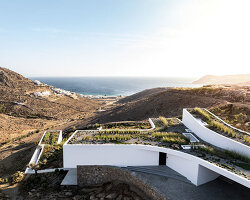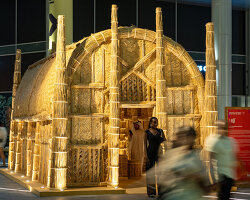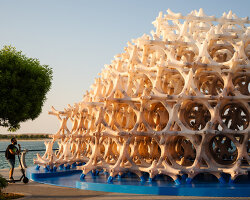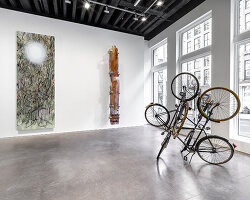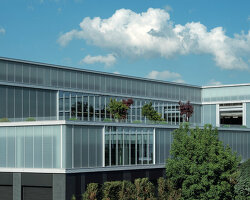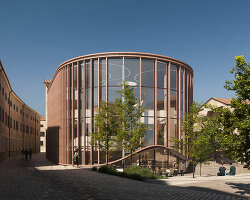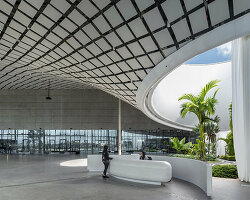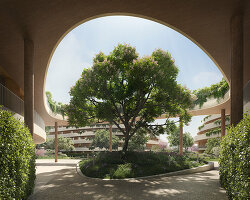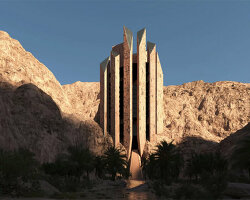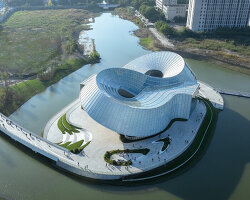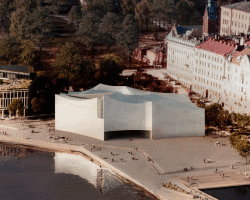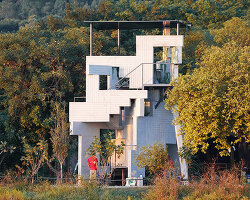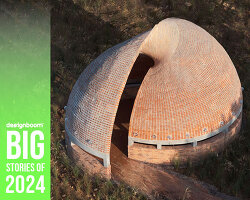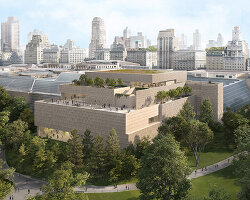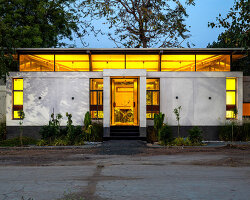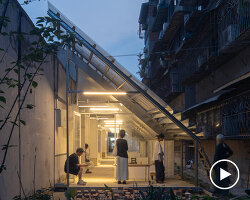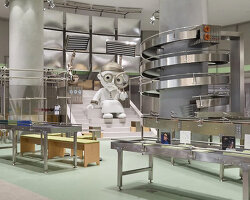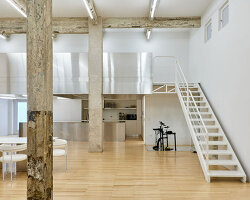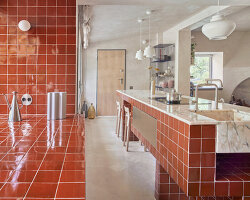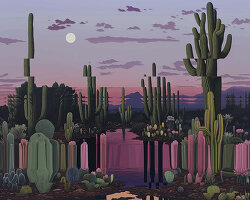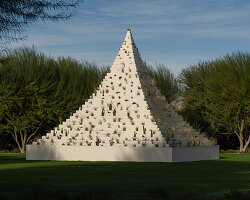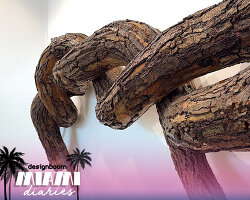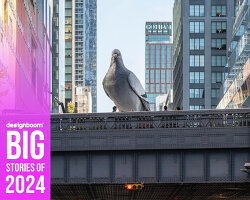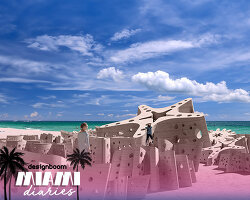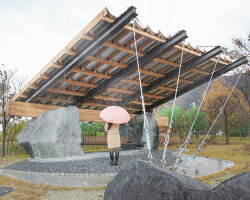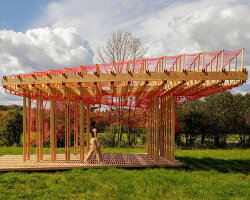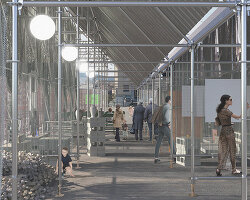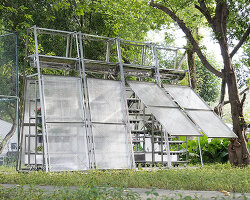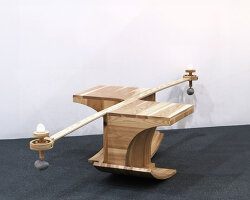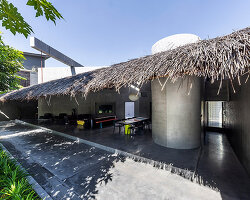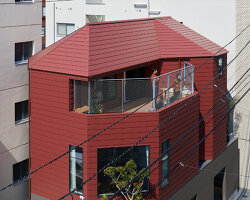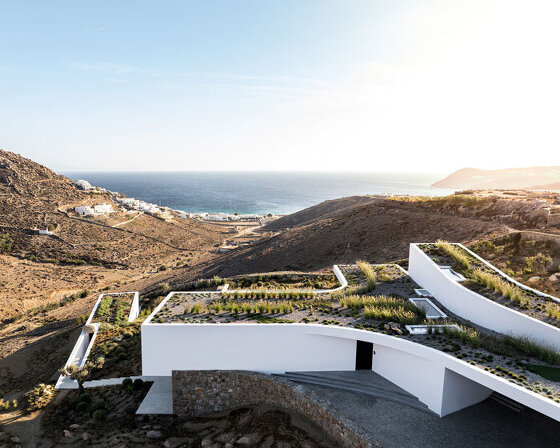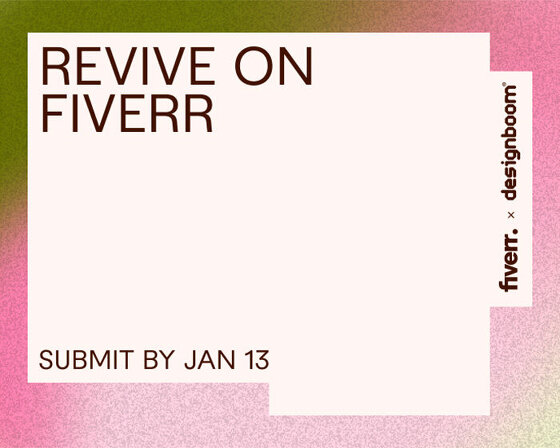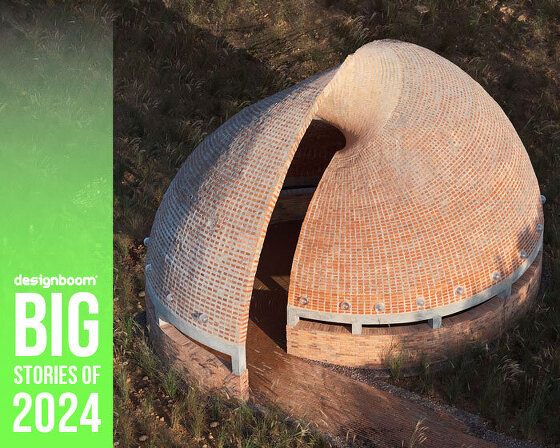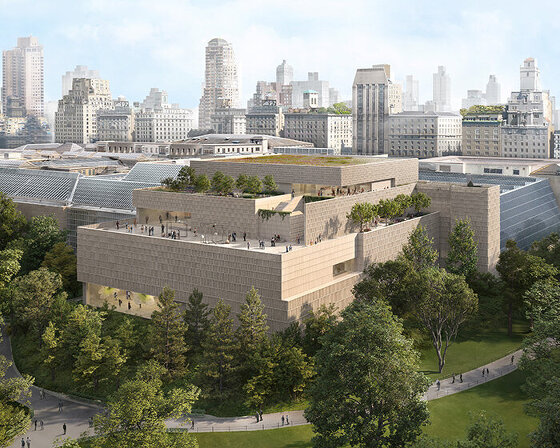Mario cucinella designs exhibit layout in palazzo citterio
Palazzo Citterio in Brera, Milan reopens with the curation of Mario Cucinella Architects, which includes the installment of a sculptural and multifunctional ticketing booth in the entrance hall and a temple-inspired wooden pavilion in the courtyard. The project is part of the rebranding initiative dubbed La Grande Brera, created by the Qubit Group with creative agency Carmi e Ubertis. The goal is to connect all the institutions within the Brera complex, including the Palazzo Citterio museum and the Biblioteca Nazionale Braidense, and allow passages to and from them all. The most recent one to be completed is the Palazzo Citterio, with the pavilion having been donated by Salone del Mobile.Milano to the Pinacoteca di Brera.
Mario Cucinella curates two of the three floors of the Palazzo Citterio, comprising the entrance hall, the courtyard where the pavilion is, and the first floor where the permanent collections are. Speaking with designboom ahead of the unveiling on December 7th, 2024, the same inuaguration day of Notre-Dame Cathedral in Paris after the fire incident in 2019, the Italian architect tells us ‘renovation’ may not be the best word to describe the project. ‘I say we ‘fixed’ some problems with the buildings because many people had worked on them over the last 40 years. We chose the colors for the rooms, worked on the lighting for the paintings, and recladded the floor, to name a few. If it’s renovation, then it was a ‘light’ one,’ he shares with designboom.
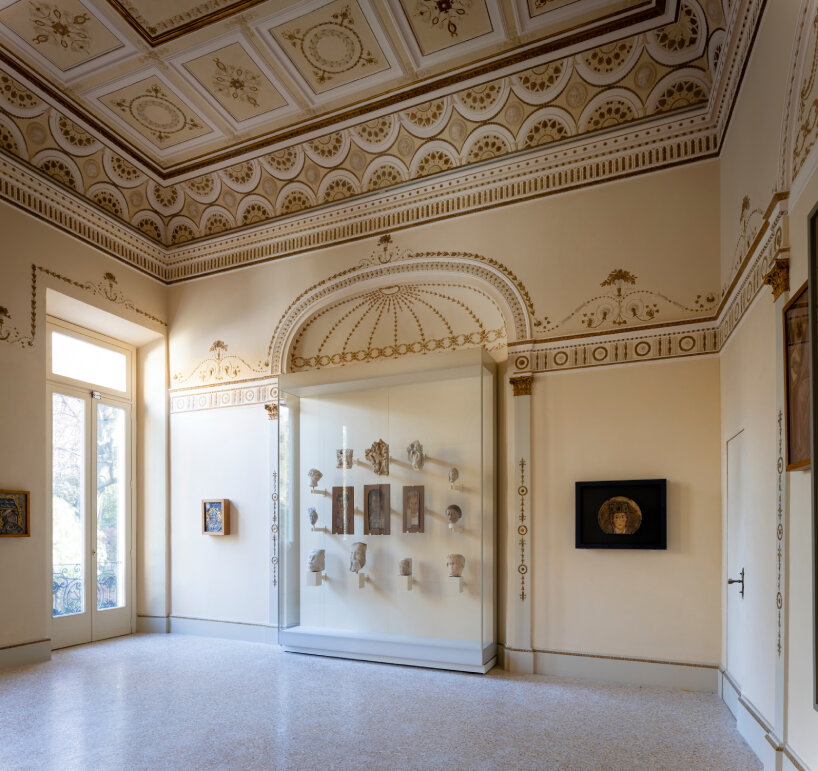
all photos by Walter Vecchio, courtesy of Mario Cucinella Architects
Sculptural ticketing booth at the entrance by mario cucinella
During our interview with the Italian architect, Mario Cucinella dissects the design of each space the team has worked on. The first is the entrance hall. When visitors step inside the recurated Palazzo Citterio, they find a swirling, multifunctional ticketing booth. Its shape resembles water waves or a flower with curling leaves, and it’s made of two materials: the entire body is forged from steel, while the surface is topped with wood. The architect describes it as a sculpture because it serves as the ticketing booth, gift shop, bookstore, and seating area at once. There’s a continuous bench that curves around the shape of the structure for visitors to sit on, and some of these parts are elevated to act like a shelf and put objects on, like books and souvenirs. Behind this massive sculpture, staff members attend to the visitors for their tickets to the exhibitions.
In front of this multifunctional sculpture, there’s an LED screen that displays digital art. Before moving upstairs, visitors can step outside the courtyard to see and be in the wooden pavilion. This has several backstories that Mario Cucinella tells designboom during our interview. He explains that the design is inspired by the Tempietto del Bramante in Rome, which is a dome-shaped building designed by Donato Bramante that has a colonnade surrounded by 16 granite columns. For the curation, the architect creates an open wooden pavilion with circular benches and a canopy of transparent plastic hanging above the visitors. At night, the lights go on, and these flimsy films diffuse the glow throughout the space. When viewed from below, the canopy resembles the structure of a coral.
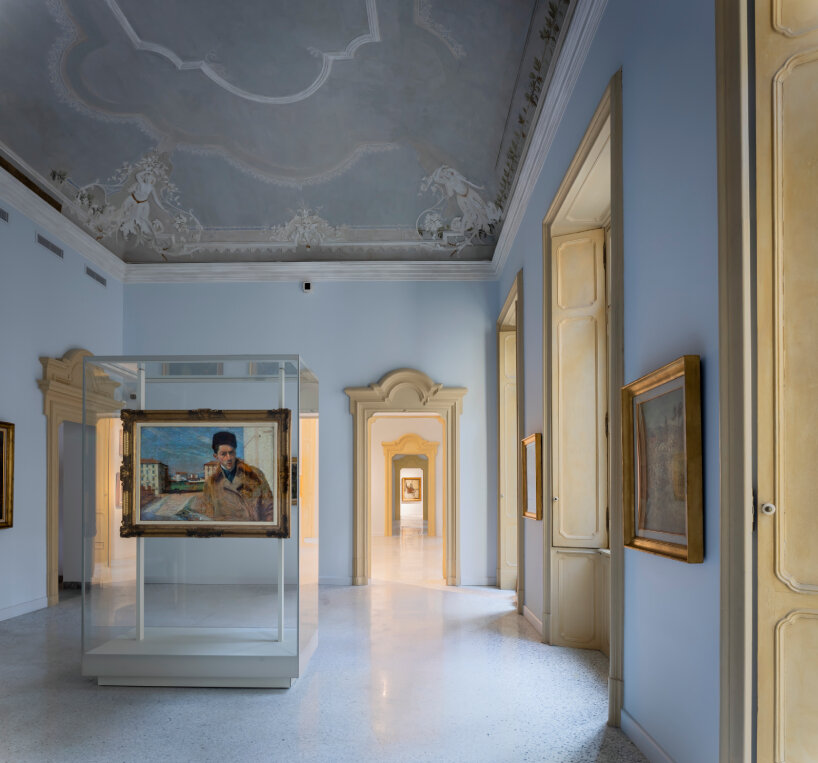
view of Piano Nobile on the first floor of Palazzo Citterio, recurated by Mario Cucinella Architects
Glass boxes for the exhibition room in palazzo citterio
Mario Cucinella adds that the temple-inspired pavilion is modular because it is imagined to be a multipurpose space. ‘Maybe around April or summertime in 2025, it will be moved to the garden because there’ll be a temporary bar set up in the middle of the courtyard,’ he explains to designboom as an example. Another design inspiration of the pavilion is tied to the painting on view at the neighboring Pinacoteca di Brera: The Marriage of the Virgin by Raphael.
In the artwork, the Tempietto del Bramante in Rome stands in the background, the center of the composition.
What ties this artwork and the wooden pavilion to La Grande Brera is that one of the last paintings visitors to Pinacoteca di Brera can see is this work by Raphael. Mario Cucinella then imagines that after visiting the public gallery, they walk towards Palazzo Citterio to see the recreated Tempietto as a wooden pavilion in the courtyard. Then, the architect then takes us to the first floor, the Piano Nobile, where the permanent collections from the Jesi and Vitali families are on view. Here, the team produces display cases for each object and historic piece. ‘If you look at them this way, I think they look more like a jewelry collection,’ the architect shares with designboom.
In fact, they do because these glass boxes fit each item they guard and make them so visible to the visitors’ viewing. These objects are placed on top of a painted table forged in steel, which is also courtesy of Mario Cucinella Architects. Instead of a single long table, the team crafts two thin steel tables that can be adjoined like puzzle pieces. A break from the design features, the architect tells designboom that he imagines the recurated Palazzo Citterio as a gathering space. It used to be an ‘empty’ space, but now, visitors can sit and hang around for a little while. They can, for example, reflect inside the pavilion and sit down at the multifunctional table by the entrance. In our conversation below, he not only points this out but also discusses the importance of creating inclusive spaces within museums.
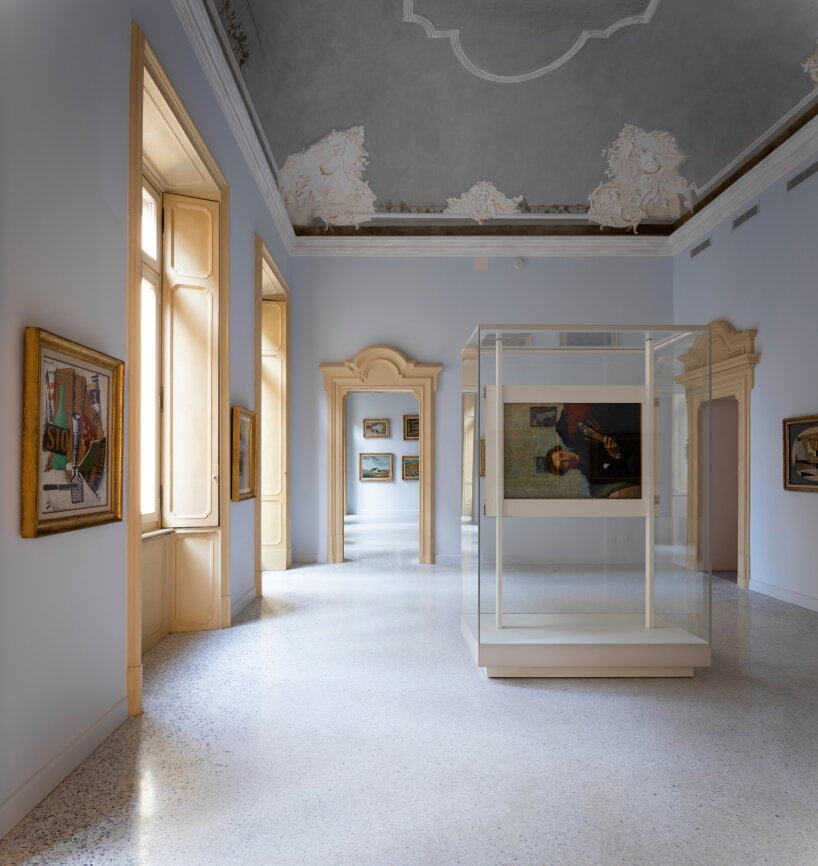
the glass boxes thought of by Mario Cucinella encase individual artworks inside Palazzo Citterio
INTERVIEW WITH MARIO CUCINELLA on PALAZZO CITTERIO CURATION
Designboom (DB): Hi Mario, it’s wonderful to be here in your studio in Milan. How do you feel about the opening of the recurated Palazzo Citterio?
Mario Cucinella (MC): I feel good. It’s the end of a long story, also because Palazzo Citterio has had renovations over the course of 30, 40 years. After so many years, there were some structural problems. We started repainting the old museum and remaking the entrance on the ground floor. It’s a sort of new furniture, like a big table. There’s ticketing, a bookshop, a place for sitting, and a big screen for digital arts. It was also designed for universal access, low and easy for people with wheelchairs to approach.
In the courtyard, we created something in memory of Bramante. In Pinacoteca di Brera, one of the last paintings is by Raffaello titled The Marriage of the Virgin. It’s an amazing painting featuring Bramante’s Tempietto, a small temple. We built this temple in the middle of the courtyard to recreate the idea of inclusion, so now there’s a feeling of inclusion of modern, contemporary objects inside a historical building. The structure is like a welcome pavilion.
DB: Since we’re talking about the entrance hall, we see that there’s a LED screen here that displays digital arts. With that around, it feels like an ampitheater. Was that an intentional design?
MC: Not really. The idea was to create a little infrastructure where people coming in find not just an object in a room but a sculpture. It’s a ticketing area, a bookshop, a gift shop, and, in the end, a bench—all connected. The screen displays digital art, so people can sit and watch. From the main road with doors open, you can catch the idea of the screen showing digital art. It’s more like a sculpture than just functionality. It’s not only a bench but an object of art. This table is made of steel, and the surface is covered in wood.
DB: And how does it work when you said it’s also a bench? Is it embedded?
MC: Yes, it’s a continuous object. You have the ticketing place, then there’s this is a bench around it so visitors can watch the LED screen. There are object lamps around, then the gift shop and the bookshop. You can come in, get your tickets, move around, watch the video or digital art, or sit there. It’s a welcoming area to the museum. It’s not just functional; it’s also nice as an object of art.
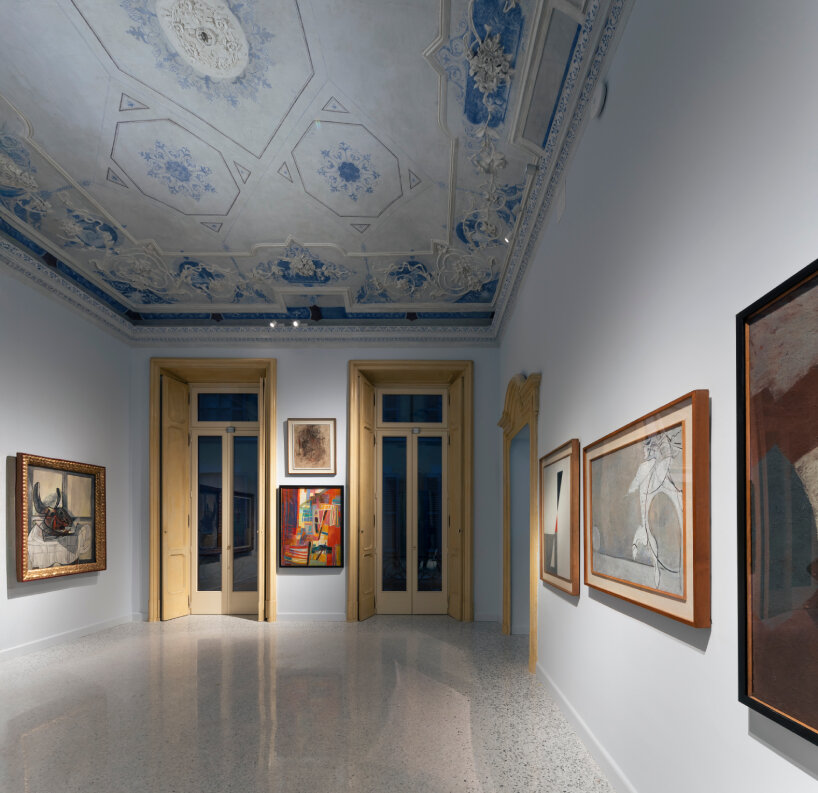
the paintings have been lowered, so people with reduced mobility can see them visibly
DB: What’s the design inspiration for this sculptural ticketing booth? It looks like water waves or even a boomerang.
MC: No. I think it was something we did already for the Salone del Mobile years ago. The idea is that the sculptures interact with the space. This is a room here, and what we do is a sort of bench like this. You can sit here, put your book there, watch the screen, and walk around this object for the bookshop. This is the ticketing place. I like the idea that it can be treated like a sculpture, an art object, but also has some function.
It’s good that when you enter the museum, the first impression is a piece of art, right? The idea was to only use steel for the base because we were looking for some mirror effect to reflect the floor. But it’s nice to have this level of wood because it’s much warmer to the touch. Mixing two materials, I think, is natural in some way. It’s not a cold object; it’s something warm, like an art object. I think it works.
DB: Let’s go to the Tempietto in the courtyard. First, what are the objects suspended above the wooden pavilion?
MC: It’s a transparent plastic, and this pavilion, it occupies the courtyard like Tempietto di Bramante in Rome. I think this dialogue is quite interesting to show that Palazzo Citterio is an old building. While it has undergone a lot of renovation, it’s still an art museum and a historic building, and some pieces of its architecture are still very good at giving a new impression. For now, this pavilion is here, but maybe around April or summertime in 2025, it will be moved to the garden because there’ll be a temporary bar set up in the middle of the courtyard.
DB: So, it’s modular architecture. Is it an intention to turn the courtyard into a multi-purpose space, or has it always been a multi-purpose space?
MC: It’s always been, yes, but with the pavilion, it’ll be a welcome place. You get in from the road, gather people here, maybe give a speech, or guide people to take the group here. Or you come from the street, sit in this temple, sit there reading your newspaper or whatever, and then get inside the museum. It’s an open, free place.
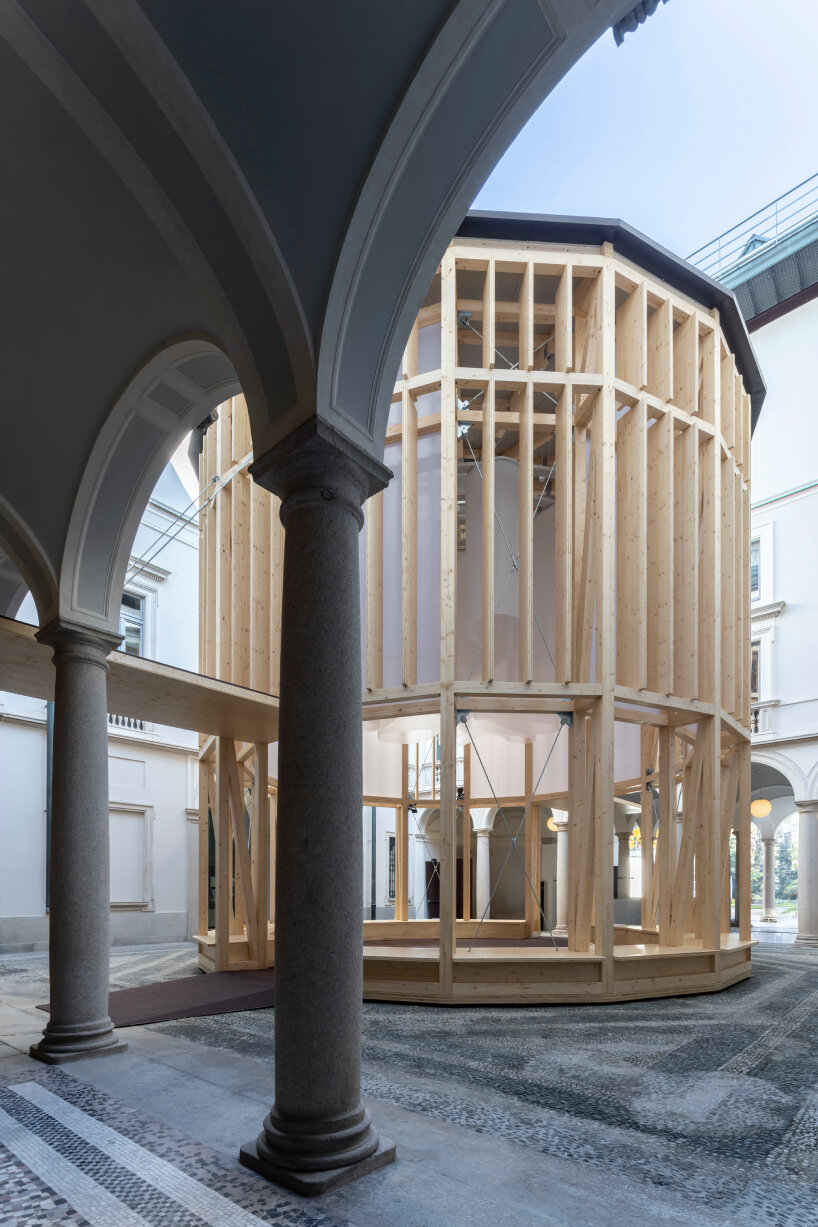
view of the temple-inspired wooden pavilion by Mario Cucinella Architects in the courtyard of Palazzo Citterio
DB: Right, and this pavilion is also inspired by Raffaello’s painting, The Marriage of the Virgin.
MC: Yes, because that painting is one of the last artworks visitors to the Pinacoteca di Brera can see, and then at the end of their tour, they can come here and see this pavilion, which is inspired by that painting. I thought it would be a wonderful connection.
DB: Why did you use transparent plastic for the canopy?
MC: It catches some light from the top, and we’ve already had this kind of experience made in one of our projects in the South of Italy for the ceiling of a church. Also, at night with light, they become very soft and airy. The building is wood, very heavy, but the transparent plastic acts kind of like a veil, a sort of vibration, I think, contrasting between these heavy things and this light.
DB: Let’s go to Piano Nobile, where the permanent collections are on view. For this space, you curated glass boxes for the objects, if we’re not mistaken?
MC: Yes, because we are integrating them into the space, which remained with the taste of last century’s building. We designed them for all the rooms, then in one room, we created a table in two parts, designed like puzzle pieces. They’re embracing like two adjoining things. These are two different colors, and the tables hold all the archaeological pieces. The table is made of steel too.
DB: Is it the first time for steel to be introduced into Palazzo Citterio as a main design element?
MC: I think so, yes, and we also wanted them to be like two pieces that can be adjoined instead of one single table. You know, there are different objects, different sizes, and I thought it was much nicer if we put glass boxes. It’s like a table from home, but you put the object. Also, it’s not a single glass covering all the archeological pieces. I think it was nicer to see all these different noises, creating a sort of little landscape on the table with these transparent, glass boxes. If you look at them this way, I think they look more like a jewelry collection, like you’re in a jewelry shop. I thought it was nice to get these different sizes and different things. This is not the right light, but now we have special light for some objects, so it’s a little more oceanographic.
DB: That’s true, and tell us about the reading room next door? We read that there’s also a place for people to stay and read their books on Piano Nobile.
MC: It’s a little room painted in Pompeii red. It’s a very eclectic room. We’ve put a sofa with a table and some books. We thought this was a kind of reading place in a museum with a setting that’s like your living room, also because you can read some of the books here.
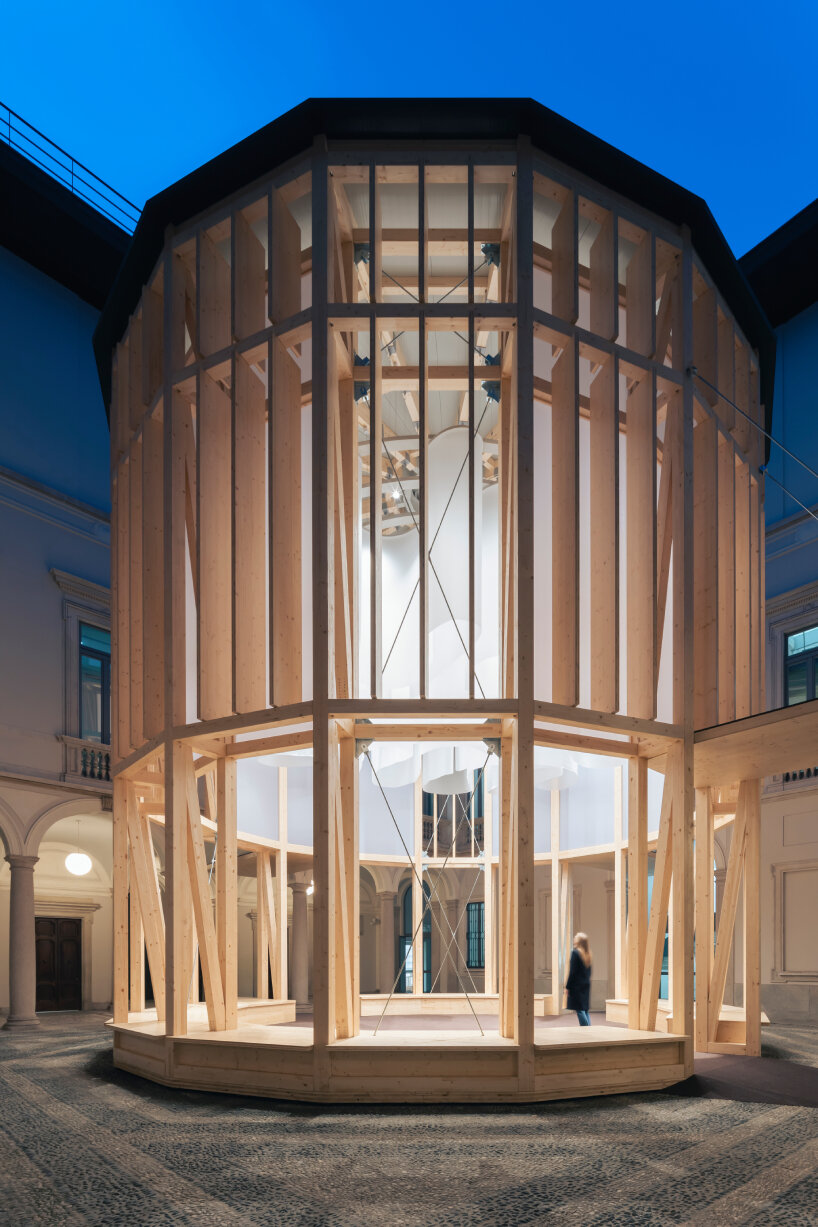
Mario Cucinella uses transparent plastic to diffuse the light inside the pavilion at Palazzo Citterio
DB: Sounds amazing! Let’s go back to the word you mentioned before, which was inclusion. Before you worked on this project, did you find a lack of inclusive spaces? Is that why you added them?
MC: We did it because it’s the idea of the commissioning director to also connect Palazzo Citterior to the Pinacoteca di Brera. The Pinacoteca has a long history, and architects over time put in some of their work, like Pierre Mariani and Portalupi. There’s a tradition in this museum with works by architects, so it’s already been influenced by different architects. I think it’s nice when the director asked me to add inclusion into the design with a sign of contemporariness to it. It’s similar to the stories of many buildings in Italy, which have different layers to them. In the case here at Palazzo Citterio, the building is historical, but the temple and the tables are contemporary.
DB: And it’s a great place now for gathering. The way you did with the structure, the bench around the sculptural ticketing booth, and the pavilion. It feels like a great space to just sit around.
MC: Yes, I think there are many museums in many parts of the world where people go inside to buy a book, sit to read something, or get a coffee. In Italy, this is not yet common. I remember years ago there was a kind of resistance, especially from museum directors, against cafeterias and these things because you go to a museum, and it’s a sacred place. But in reality, when you go to many places like MoMA or others, it’s a little bit commercial, but you can sit on a sofa, watch a piece of art without paying a ticket, or gather in the restaurant and enjoy the atmosphere.
I think Palazzo Citterio wants to be something like this, more like Pinacoteca. They already have a bar, a library, but it’s still a one-function museum. I think they want to make it more of a place for people to go, get a coffee, buy something, visit the place, and watch digital art sitting there. They want to connect more with the everyday life of people, like churches in the past where people went to see a Caravaggio or beautiful architecture without paying a ticket. It was part of the social life. I think this is the way to open a museum because, while you can pay for a ticket, you can first enjoy the space. I think this is a good evolution.
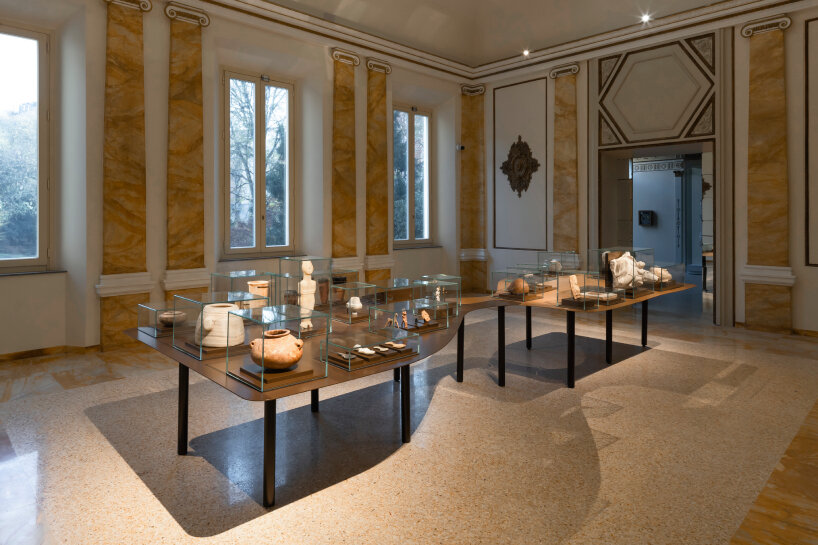
view of the table thought of by Mario Cucinella that can be adjoined like puzzle pieces inside Palazzo Citterio
DB: Considering this renovation – or rather, curation or completion of the design – how accessible is it for everyone, including visitors with reduced mobility?
MC: For example, we adjusted the height of the sculptural ticketing booth, so it’s easy for anyone to reach it. Then, with the benches integrated around it, people with wheelchairs can stay there while others still have access to other free seats. The height of the furniture is also low to accommodate people with low mobility, as well all the paintings. Normally, paintings on the wall are put at 150 centimeters, but for a person sitting in a chair, it is too high.
So, now the level is 110 centimeters low. We put the paintings down just a little bit to provide easier vision for people with reduced mobility. This is a form of universal design, so all people can access it. Even if you are a little lower, it’s the same for me, but for people in a chair, it makes a difference. We also designed the courtyard and all access with a little ramp, so there will be no difficulty moving around. This is horizontal; it’s for everybody.
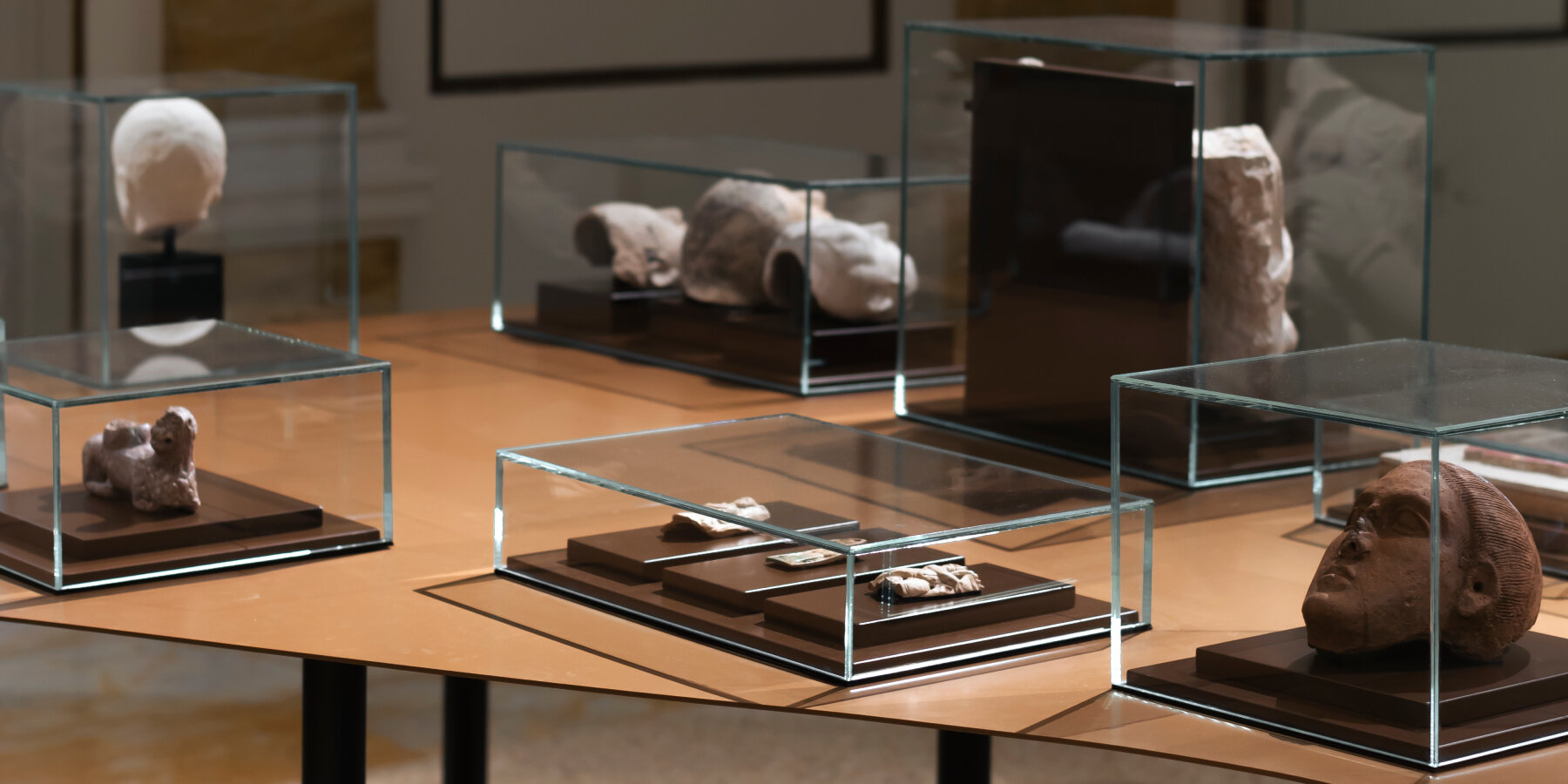
the setup resembles jewelry collection
project info:
name: Palazzo Citterio
location: Brera, Milan
curation: Mario Cucinella Architects | @mario_cucinella_architects, @mariocucinella
design leader: Donato Labella
architect: Michela Galli
visual unit manager: Alessia Monacelli
visual artist specialist: Vincenzo Metafora
tempietto construction and donation: Salone del Mobile.Milano
reading room furniture donation: Spotti Srl
lighting donation for tempietto and hall table: Artemide S.p.A.
display cases: Goppion S.p.A.
hall table and exhibition table: OfficineTamborrino
tempietto: WAY spa
wood paneling restoration: Mauro Spinelli
doors: Vetreria Busnelli S.r.l.
general contractor: Fratelli Navarra
photography: Walter Vecchio | @waltervecchio_ph
happening now! ahead of the event running from january 17 – 26, Singapore Art Week 2025 reveals the 130 events set to transform the island into a dynamic stage for creativity, collaboration, and community engagement.
